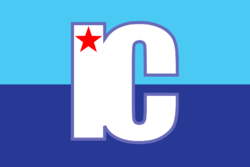| Flag | Date | Use | Description |
|---|
 | 1477–1541 | Inca Imperial Banner | Two long yellow snakes on the sides, in the center a green, yellow and red rainbow, with the crown of the Inca sapa. |
 | 1506–1701
16th and 17th centuries | Mapuche military flag during the Arauco War | Blue field with a guñelve (eight-pointed star). |
 | ?–1557 | Mapuche flag, used by Lautaro forces, in Arauco War | Light blue gemil with a guñelve star bordered by black triangles |
 | ?–1557 | Standard of the Toqui. | a red swallowtailed field with a guñelve star |
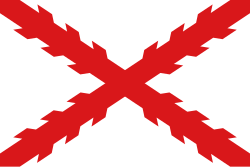 | 1541–1785 | Burgundy Cross, flag of the Spanish forces in Arauco War and flag of the Spanish Overseas Territories | A red saltire resembling two crossed, roughly-pruned (knotted) branches, on a white field. |
 | 1785–1812 | Spanish national flag and war ensign | |
| 1814–1817 |
 | 19th Century | Selkʼnam Flag | This version of the Selkʼnam flag was created in a sewing workshop in the late 19th century by Selkʼnam girls and women at the Salesian Mission of San Rafael on Dawson Island, Chile. The design of this flag responds to the fact that according to their mythology when they died they became stars. |
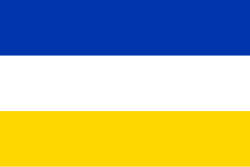 | 1812–1814 | First National Flag, also called Bandera de la Patria Vieja ("Old Fatherland Flag") | Three horizontal strips blue, white and yellow. |
 | Alternative version of the First Chilean flag | Different order of the strips, with the first Chilean coat of arms and a red Cruz de Santiago (Cross of St. James) in the top left corner. |
 | 1814–1817 | The Flag of Macha | A horizontal triband of light blue (top), white and light blue. |
 | Flag of the Andes, ensign of the Army of the Andes, now the provincial flag of Mendoza (Argentina) | Two rectangles, white and light blue, with the coat of arms in the center. |
 | 1817–1818 | Second National Flag, now also called Bandera de Transición ("Transitory flag") | Tricolour similar to flag of Yugoslavia, Three horizontal strips blue, white and red. |
 | 1818, only a few days | Alternative flag | Tricolour similar to flag of Russia, Three horizontal strips white, blue and red, with a white star in blue strip. |
 | 1818–1834 | First design of the actual flag, also called Bandera de la Independencia ("Independence Flag") | Similar to flags of Texas, Poland, and Czechoslovakia, and to actual ensign for Chilean Independence flag, with the coat of arms in the center, and a black eight-pointed star within the white five-pointed star. |
 | 1818–1912 | National flag | Design of the flag with the star tilted. |
 | 1818–1819 | Flag of the United Provinces | A horizontal tricolor of light blue (top), white and light blue with the Sun of May in the center. |
| 1820–1825 |
 | 1819–1820 | A horizontal tricolor of blue (top), white and blue with the Sun of May in the center. |
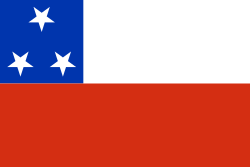 | 1820–1822 | Flag used in Liberating Expedition of Peru | Similar to the national flag, with 3 stars |
 | 1821–1822 | Flag of The Protectorate of San Martín (in Tarapacá, Arica & Parinacota) | 2 triangles of white and red with the coat of arms in the center. |
 | 1822 | Flag used in Peru (in Tarapacá, Arica & Parinacota) | A horizontal triband of red (top), white and red with the inca sun in the center |
 | 1822–1825 | A Vertical triband of red, white and red with the inca sun in the center |
 | 1825–1826 | Flag of Bolivia (in Antofagasta) | A vertical tricolor of green, red and green with 5 golden 5-pointed stars decorated with a laurels in the center of the red band |
 | 1825–1836 | Flag used in Peru (in Tarapacá, Arica & Parinacota) | A Vertical triband of red, white and red with the coat of arms in the center |
| 1839–1884 |
 | 1825–1904 | Flag of The Litoral Department | a horizontal tricolor of blue, red and yellow with the coat of arms off-centred toward the hoist. |
 | 1826–1831 | Flag of Bolivia (in Antofagasta) | A vertical tricolor of green, red and green with a horizontal yellow band upwards and the coat of arms in the center |
 | 1826–1854 | Civil flag | |
 | 1831–1851 | Flag of Bolivia (in Antofagasta) | A horizontal tricolor of yellow, red and green with the coat of arms in the center of the red band |
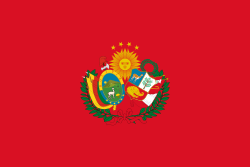 | 1836–1839 | Flag of The Peru–Bolivian Confederation (in Antofagasta, Tarapacá, Arica & Parinacota) | A red field with the arms of north and south peru and bolivia in the center. |
 | Flag of South Peru (in Tarapacá, Arica & Parinacota) | A vertical field of red color on the left (with a sun and four stars) and two horizontal fields on the right of green (above) and white (below). |
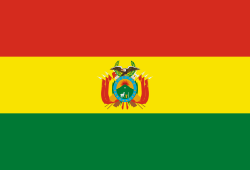 | 1851–1904 | Flag of Bolivia (in Antofagasta) | A horizontal tricolor of red, yellow and green with the coat of arms centered in the yellow band. |
 | 1860–1862 | Flag of the Kingdom of Araucanía and Patagonia | Three horizontal strips blue, white and green. |
 | 1860s | A recreation of Dutrou-Bornier's flag. | |
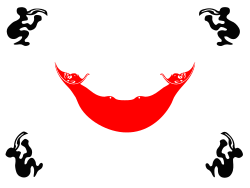 | 1880–1888 | Flag of the Kingdom of Easter Island | Similar to actual Reimiro flag, with four black manutaras (mythological bird) in each corner. |
 | 1884–1929 | Flag used in Peru (in Tarapacá, Arica & Parinacota) | A Vertical triband of red, white and red with the coat of arms in the center |
 | 1888–1902 | Flag of Easter Island | Similar to the flag of Chile, with white and red fields reversed, and the star in the blue canton replaced by Christian and traditional Rapa Nui symbols. Used during the first years after the annexation until the arrival of the ship Baquedano in 1902. |


































































